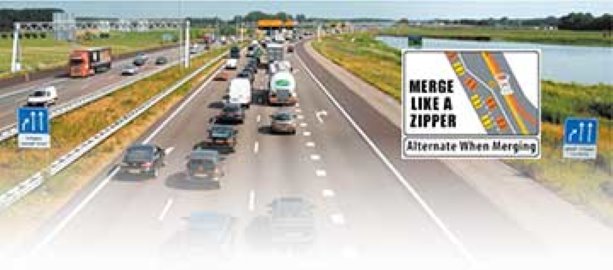Drivers are often conflicted as they approach road construction sites where signs indicate that traffic lanes are about to merge. Should they merge early on in a display of civic courtesy, or should they greedily move to the head of the disappearing lane, hoping to squeeze in at the front of the line?
Studies indicate that the best option may be to simply “zipper merge”— remaining in one’s own lane, and then politely alternating entry at the pylons. Traffic experts note that merging too early increases traffic back-ups by leaving a near-empty lane that normally handles significant volume and creating massive gridlock in the other. Cranky drivers in the slow lane, in turn, punish eager drivers in the other by refusing to give way at the merge point. The chaos and speed differential between the two lanes also threatens the safety of construction crews as some drivers suddenly slam on their brakes or veer to avoid collisions.
The zipper merge, under various names, has caught on around the world, and was recently examined in a May 2013 pilot study in the City of Saskatoon. The study was conducted on a road construction project at Circle Drive North, which resulted in significant lane closures on a stretch of road that typically sees the taillights of 80,000 vehicles per day. Traditionally, a merge had been announced using a sign reading “Lane Ends Ahead.”
“There’s a prevailing impression that merging at the last minute is a bad thing,” says Angela Gardiner, transportation branch manager with the City of Saskatoon. “This was new and different for the city. To familiarize our drivers with what was expected of them, we conducted a public awareness campaign in advance, using our website, TV, and radio.”
The city provided message boards at the site that offered step-by-step instructions to drivers, indicating that a construction zone was ahead, that a lane closure was approaching, and that they were to remain in their own lanes. A final sign identified the location where vehicles were supposed to merge.
Although the city considered stationing police officers at the merge point, initial driver response was so positive that no further encouragement was necessary, says Gardiner.
“We wanted to quantify the impact of the study, but the contractor finished the job so quickly that we weren’t able to collect exact metrics,” she says. “However, based on other test sites in the city and on informal feedback from contractors and the public, we’re planning to implement zipper merges in our work zone standard later this year.”
Other provinces, such as British Columbia, have also conducted pilot projects. The province’s Ministry of Transportation and Infrastructure has already developed a prototype highway sign that is ready to go into production when needed.
South of the border, the Minnesota Department of Transportation (MnDOT) has been promoting the zipper merge since 2002 and says it’s been responsible for reducing construction zone congestion by as much as 50 per cent, while also reducing the number of accidents. With vehicles in both lanes traveling at approximately the same speed, merging also becomes safer and improves the safety of construction crews.
“We’re using education, not enforcement, to modify driver behaviour,” says Kevin Gutknecht, communications director with MnDOT. “While zipper merging offers the greatest benefits in construction zones, I’ve seen drivers begin to adopt this habit at ordinary lane merges on highways. People have asked me if I think that the program works here because Minnesotans are especially nice. I tell them that it works because Minnesotans are extremely bright and understand that they’re making better use of roadway capacity.”



Recent Comments
comments for this post are closed